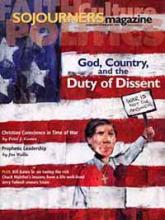At the corner of 14th and Euclid Streets NW in Washington, D.C., many evenings at sunset, the Domino's deliveryman kneels down to pray.
About 50 years old, he wears dark pants, white high-top sneakers, and the pizza company's bright red shirt. In the dusty space between the cracked sidewalk and the asphalt, between the traffic light pole and a chipped green fire hydrant, he lays down a faded prayer rug and faces the rose-washed bricks of the Olympia apartment building toward the east.
This street corner is what historian of religion Mircea Eliade would call "profane space." It is homogenous; no place is more significant than another. There is no center to it. The Amoco station is physically the same as every other Amoco station. Late night patrons regularly hear rounds of gunshots and hit the ground. Cars run the stoplightsour symbols of order. The occasional shooting deaths complete the chaos.
Profane space is chaotic space, without shape or order. Profane space leads to a lack of reality; a dismantling of humanness.
As the sun slants behind him in the west, the Domino's deliveryman lays out his blue and tan prayer rug and removes his shoes. Perhaps he thinks that this place is not as clean as it should be; or mourns that he is not with a community of believers. Perhaps he feels guilty that, with his work schedule, he cannot complete all the sunset prayers.
Still, he touches his forehead to the ground.
AT THAT MOMENT of prayer, he is not simply one more object in the urban landscape. Rather he has become a hierophanya disruption of profane space by the manifestation of the divine. His act of praying transforms the cityscape into sacred space, holy ground. Moses sees a burning bush. Mary sees an angel. What does the pizza man see?
Read the Full Article
